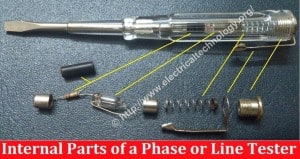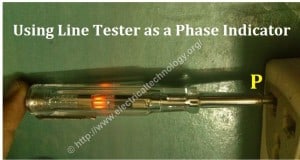Phase or Line Tester
Phase or Line Tester is a tool which is used to identify or test the Phase/Live/Hot or Positive wire/Conductor.
Phase or Line Tester is also called Neon Screw Driver or Test Pin.
(Good to Know: Phase, Line, Hot, Live and Positive are the same terms)

Construction of Phase or Line Tester
Following are the main parts of a typical Phase or Line Tester.
1). Metallic Rod and Mouth
It is a cylindrical metal rod. The flat end (mouth) is used as a screw driver or touch electrical conductors/wires to find phase or live wires and the other end is connected to the resistance, neon bulb, element and metallic cap screw respectively. The flat end of cylindrical metal rod is also covered with transparent insulated plastic for insulation proposes except mouth.
2). Body and Insulation
All these components (Resistance, Neon bulb, Element or metallic spring, and Metallic Cap screw) are covered in a transparent insulated body which made of plastic. The flat end of cylindrical metal rod is also covered with transparent insulated plastic for insulation proposes except mouth.
3). Resistor
Resistor is an element which opposes the flow of current through it. In a Phase or Line Tester, Resistor is connected between cylindrical metal rod and Neon bulb to prevent high current and reduces it to a safe value for Neon bulb. Without a resistor, high current may damage the neon bulb. Moreover it would not be a safe to use this tool without resistor.
4). Neon Bulb
Neon bulb is connected between Resistance and Element (metallic spring). It is used as phase indicator bulb. When a small current flows through it, then it glows. Due to neon bulb, a Phase or Line tester is also called a Neon Screw driver.
5). Element (Metallic Spring)
Element (metallic spring) is used to make connection between neon bulb and metallic cap screw.
6). Metallic Cap Screw and Clip
Metallic Cap screw is used for tight all the components inside the Phase tester slot. In addition, Metallic cap screw is connected with spring (element) and spring (element) is connected with neon bulb. Moreover Clip is used for holding the phase tester in pocket.
Click image to enlarge
Click image to enlarge
Working of a Phase or Line Tester:
When we touch mouth (flat end of the Metallic rod) of Phase or Line tester with naked Live / hot wire whereas one of our finger touch the metallic Cap Screw or Clip of Phase/Line Tester, then circuit is completed and current start to flow in Metallic rod.
Metallic rod is connected to the resistor which reduces high current to a safe value. The reduced Current passes through Neon bulb which is connected to (metallic spring). Metallic spring is connected with metallic Cap screw which is in contact of our fingers. A very small current passes through our body to earth and complete the circuit. When circuit is completed, current starts to flow and the filament of neon bulb starts glowing. This indicates that the touched wire with Phase/Line Tester mouth is Phase/Line/Hot.
(Good to Know: Phase, Line, Hot, Live and Positive are the same terms)
If we perform the same action as mentioned above, and Neon bulb does not glow, it means that is a Neutral Wire/Conductor.
Click image to enlarge
Safety Precaution:
- Never try to work on electricity without proper guidance and care
- Work with electricity only in presence of those persons who has good knowledge and practical work to deal with electricity
- Don’t touches the open wire/Conductor even tester shows absence of phase or hot supply
- Use Line Tester only with 100V-500V
- Don’t use Phase or Line Tester with High voltages
- Don’t hit on the handle of Line tester otherwise, Neon bulb or element may damage.





